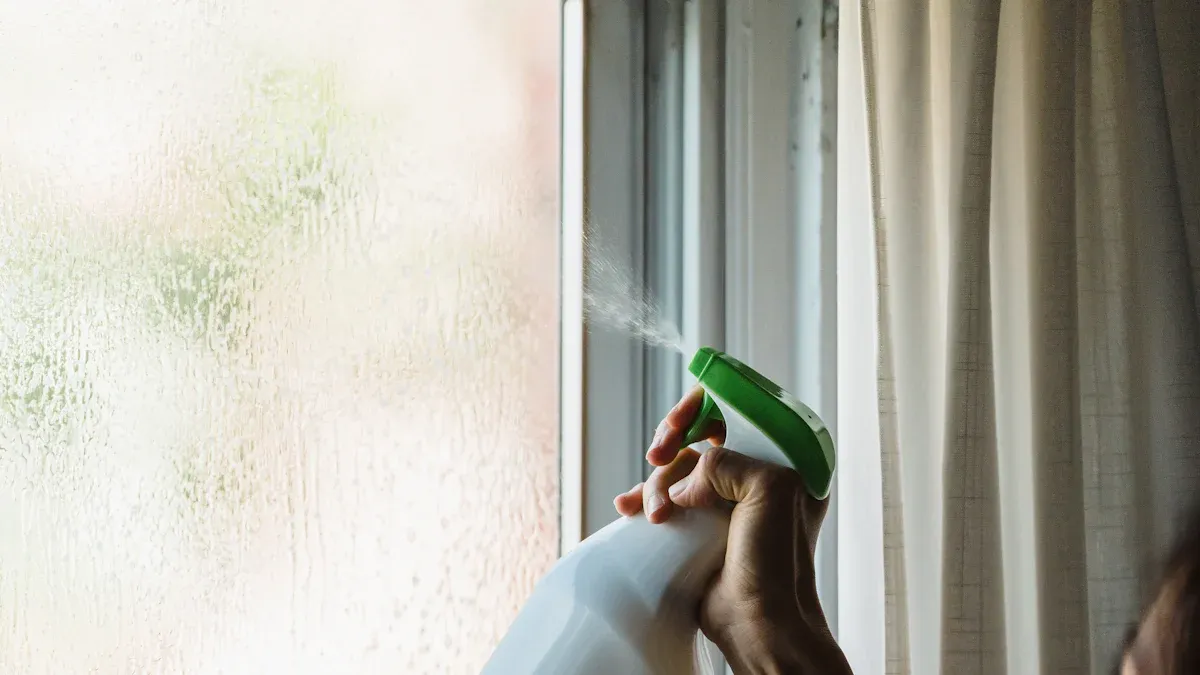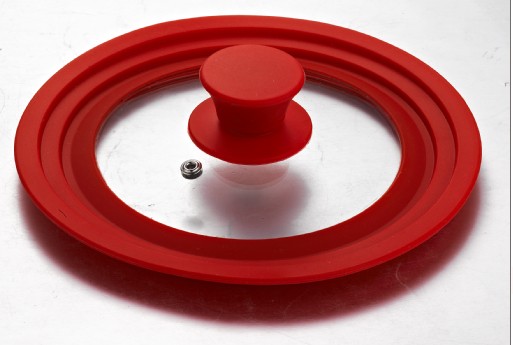Proper maintenance of silicone glass lids, including the silicone smart lid and the cookware glass lid, extends their lifespan and reduces replacement costs. These versatile lids, such as the silicone glass lid pan cover and the oval glass lid for roaster, offer durability and adaptability when cared for correctly. The global silicone structural glazing market, valued at USD 44.87 billion in 2023, is projected to grow at a CAGR of 7.6% by 2030. This growth underscores the value of preserving such products, including the rectangular glass lid. Neglecting care can lead to waste, while regular cleaning and correct storage ensure long-term usability.
Key Takeaways
- Clean silicone glass lids often with gentle soap and warm water. This stops stains and smells, keeping food safe.
- Keep silicone glass lids in a cool, dry spot. Do not stack heavy things on them to avoid bending.
- Check silicone glass lids for damage like cracks or stickiness. Replace them if they don’t seal well to keep food fresh.
Benefits of Silicone Glass Lids
Durability and Flexibility
Silicone glass lids are renowned for their exceptional durability and flexibility, making them a reliable choice for modern kitchens. Silicone, as a material, is inherently robust and resistant to wear and tear. This quality ensures that these lids can withstand frequent use without losing their structural integrity. Additionally, their flexibility allows them to adapt to various cookware shapes, providing a snug fit that enhances cooking efficiency.
- Silicone exhibits excellent durability across a wide range of temperatures, making it suitable for both hot and cold applications.
- Its microwave-safe properties add convenience, enabling users to reheat food without transferring it to another container.
- Research highlights that silicone kitchen utensils, including lids, maintain their flexibility and durability even under extreme conditions.
These features make silicone glass lids a cost-effective and long-lasting solution for everyday cooking needs.
Heat Resistance and Safety
Silicone glass lids excel in heat resistance, ensuring safe and efficient cooking. They can endure temperatures ranging from -40°F to 446°F, making them suitable for various cooking methods, including stovetop simmering and oven baking. This wide temperature tolerance minimizes the risk of damage during use.
- Silicone is non-toxic and non-stick, simplifying cleaning and ensuring food safety.
- Extensive testing confirms that silicone lids are BPA-free and free from harmful chemicals, making them safe for food contact.
- While generally safe, users should avoid exposing silicone glass lid pan cover to very fatty foods at high temperatures to prevent potential chemical leaching.
The combination of heat resistance and safety makes silicone glass lids a practical and reliable choice for any kitchen. Their ability to maintain performance under diverse conditions ensures peace of mind for users.
Cleaning Silicone Glass Lids

Proper cleaning of silicone glass lids ensures their longevity and maintains their functionality. Following the right techniques prevents damage and keeps them looking and performing like new.
Gentle Cleaning Techniques
Silicone glass lids require a delicate approach to cleaning. Using mild dish soap and warm water is the most effective way to remove grease and food residue without harming the material. A soft sponge or cloth works best for scrubbing the surface gently.
- Step-by-step cleaning process:
- Rinse the lid under warm water to loosen debris.
- Apply a small amount of dish soap to a sponge or cloth.
- Gently scrub the silicone and glass components in circular motions.
- Rinse thoroughly to remove soap residue.
- Dry with a lint-free towel to prevent water spots.
Tip: For stubborn stains, soak the lid in a mixture of warm water and a tablespoon of baking soda for 15 minutes before scrubbing.
Regular cleaning using these methods preserves the integrity of the silicone glass lid and ensures it remains safe for food use.
Avoiding Abrasive Materials
Abrasive materials can scratch the glass surface or degrade the silicone over time. Avoid using steel wool, scouring pads, or harsh cleaning agents like bleach. These can compromise the lid’s durability and appearance.
Instead, opt for non-abrasive tools such as microfiber cloths or silicone-safe brushes. These tools effectively clean without causing damage. Additionally, avoid sharp objects to scrape off stuck-on food. A plastic scraper or a soft-bristled brush is a safer alternative.
Note: Prolonged exposure to harsh chemicals can weaken the silicone, reducing its flexibility and heat resistance.
By steering clear of abrasive materials, users can maintain the smooth finish and functionality of their silicone glass lids.
Preventing Stains and Odors
Silicone is prone to absorbing odors and stains if not cleaned promptly. To prevent this, rinse the lid immediately after use, especially when exposed to acidic or strongly pigmented foods like tomato sauce or curry.
For persistent odors, a natural deodorizing solution can help. Mix equal parts of white vinegar and water, then soak the lid for 30 minutes. Rinse thoroughly and air dry. Baking soda can also be used as a gentle scrub to remove discoloration.
| Common Issues | Prevention Tips |
|---|---|
| Stains | Rinse immediately after use. Avoid prolonged contact with staining foods. |
| Odors | Use vinegar or baking soda solutions for deodorizing. |
Pro Tip: Store silicone glass lids in a dry, well-ventilated area to prevent moisture buildup, which can lead to odors.
By adopting these practices, users can keep their silicone glass lids free from stains and odors, ensuring they remain hygienic and visually appealing.
Storing Silicone Glass Lids
Preventing Deformation
Proper storage is essential to maintain the shape and functionality of silicone glass lids. Silicone, while flexible, can deform if subjected to prolonged pressure or improper stacking. To prevent this, users should avoid placing heavy objects on top of the lids during storage. Flat storage in a single layer is the most effective method to preserve their original form.
When stacking is unavoidable, placing a soft barrier, such as a microfiber cloth, between each lid can minimize pressure and reduce the risk of deformation. Hanging the lids using hooks or wall-mounted racks is another practical solution. This method not only prevents warping but also saves space in crowded kitchen cabinets.
Tip: Always ensure the lids are completely dry before storage to avoid moisture-related issues like mold or mildew.
Ideal Storage Conditions
Silicone glass lids perform best when stored in a cool, dry environment. Exposure to extreme temperatures or direct sunlight can weaken the silicone over time. A well-ventilated cabinet or drawer is an ideal location. Avoid storing lids near heat sources, such as ovens or stovetops, to maintain their durability.
To ensure optimal performance, users should select lids that meet safety and quality standards, such as FDA or LFGB compliance. These certifications guarantee that the lids are heat-resistant, durable, and safe for food contact. The following table summarizes key guidelines for storing silicone glass lids:
| Guideline | Description |
|---|---|
| Heat Resistance | Silicone lids should withstand temperatures from -40°C to 230°C, ensuring safety in various appliances. |
| Durability and Flexibility | Lids must be robust yet flexible to fit different container shapes and maintain functionality. |
| Compliance with Standards | Choose lids that meet FDA and LFGB standards for safety and quality assurance. |
| Airtight Seal | Creates a seal to preserve food freshness and extend shelf life. |
| Leak-Proof | Prevents spills, especially useful for storing liquids. |
| Dishwasher Safe | Ensures easy cleaning and maintenance of hygiene standards. |
| Storage Tip | Dry lids completely before storage to avoid mold or mildew. |
By following these storage practices, users can extend the lifespan of their silicone glass lid and ensure it remains in excellent condition for years to come.
Using Silicone Glass Lids with Heat

Temperature Limits
Silicone glass lids are designed to endure a wide range of temperatures, making them suitable for various cooking methods. Silicone, as a material, exhibits exceptional durability and heat resistance. It can withstand temperatures from -40°F to 446°F without losing its structural integrity. This resilience ensures that these lids remain functional even under extreme heat or cold conditions. Users can confidently use them for stovetop cooking, oven baking, or even freezing food. However, exceeding the recommended temperature range may compromise the material’s performance and longevity.
Safe Use in Ovens and Microwaves
Silicone glass lids are safe for use in both ovens and microwaves, provided they meet safety standards. Their heat-resistant properties make them ideal for reheating or cooking food without the risk of warping or releasing harmful substances. Key benefits of using these lids in such appliances include:
- Durability under high heat, ensuring consistent performance.
- Non-reactive properties that prevent chemical leaching into food.
- FDA approval, which guarantees their safety for food contact.
When using silicone glass lids in ovens or microwaves, users should always check the manufacturer’s guidelines to ensure compatibility with specific appliances.
Avoiding Thermal Shock
Thermal shock occurs when a material experiences a sudden and extreme temperature change, potentially causing damage. Silicone glass lids, while durable, are not immune to this phenomenon. To prevent thermal shock, users should avoid placing hot lids directly onto cold surfaces or exposing them to rapid temperature shifts. For example, after removing a lid from a hot oven, it is best to place it on a heat-resistant mat rather than a cold countertop. Gradual temperature transitions help maintain the lid’s integrity and extend its lifespan.
Tip: Always allow silicone glass lids to cool naturally before cleaning or storing them to avoid unnecessary stress on the material.
Troubleshooting Silicone Glass Lids
Even with proper care, silicone glass lids may encounter issues over time. Addressing these problems promptly can restore their functionality and extend their lifespan. Below are common challenges and effective solutions.
Removing Stains
Stains on silicone glass lids often result from exposure to strongly pigmented foods like tomato sauce or curry. These stains can diminish the lid’s appearance but are usually removable with the right techniques.
Steps to Remove Stains:
- Create a cleaning paste by mixing baking soda with a small amount of water.
- Apply the paste to the stained area and let it sit for 15-20 minutes.
- Gently scrub the surface using a soft-bristled brush or sponge.
- Rinse thoroughly with warm water and dry with a lint-free cloth.
For tougher stains, soaking the lid in a solution of white vinegar and warm water (1:1 ratio) for 30 minutes can help. After soaking, scrub gently and rinse.
Tip: Regular cleaning after each use prevents stains from setting in, keeping the silicone glass lid looking new.
Fixing Warping
Warping occurs when silicone glass lids are exposed to uneven pressure or extreme temperatures. This issue can affect the lid’s ability to form a proper seal, reducing its effectiveness. Fortunately, minor warping is often reversible.
Steps to Fix Warping:
- Submerge the warped lid in hot water (not boiling) for 5-10 minutes.
- Carefully remove the lid and place it on a flat, heat-resistant surface.
- Use a heavy, flat object (like a cutting board) to press the lid gently into shape.
- Allow the lid to cool completely under the weight before removing the object.
Note: Avoid exposing silicone glass lids to sudden temperature changes, as this can cause warping. Gradual heating and cooling are key to maintaining their shape.
Restoring Flexibility
Over time, silicone may lose some of its flexibility due to prolonged use or exposure to harsh conditions. Restoring flexibility ensures the lid continues to provide a snug fit and optimal performance.
Steps to Restore Flexibility:
- Soak the lid in warm, soapy water for 15-20 minutes to soften the material.
- Rinse thoroughly and dry with a clean towel.
- If flexibility remains an issue, apply a small amount of food-grade mineral oil to the silicone surface. Rub it in gently to rehydrate the material.
Pro Tip: Store silicone glass lids in a cool, dry place to prevent them from becoming brittle over time. Proper storage conditions help maintain their flexibility and durability.
By addressing these common issues, users can ensure their silicone glass lids remain functional and reliable for years to come.
Replacing Silicone Glass Lids
Signs of Wear and Tear
Over time, silicone glass lids may exhibit signs that indicate the need for replacement. Recognizing these signs early ensures continued safety and functionality in the kitchen. Common indicators include:
- A sticky texture on the silicone surface, which suggests material degradation.
- An unpleasant odor that persists despite thorough cleaning.
- Visible tears or cracks in the silicone or glass components.
These issues compromise the lid’s ability to form an airtight seal, reducing its effectiveness in preserving food freshness. Regular inspections help identify these problems before they worsen.
Persistent Stains or Odors
Stains and odors that resist cleaning efforts often signal the end of a silicone glass lid’s usability. Prolonged exposure to acidic or strongly pigmented foods can cause discoloration that becomes permanent. Similarly, odors absorbed over time may linger despite using deodorizing solutions like vinegar or baking soda. When these issues persist, replacing the lid ensures food safety and hygiene.
Loss of Functionality
A silicone glass lid that no longer performs its intended functions should be replaced. This includes lids that fail to create a proper seal, leading to leaks or spills. Warping, which prevents the lid from fitting securely, also reduces its effectiveness. Additionally, lids that lose their flexibility may no longer adapt to different cookware shapes. Replacing such lids restores convenience and reliability in the kitchen.
Tip: Investing in high-quality replacements ensures durability and long-term performance, reducing the need for frequent replacements.
Proper care of silicone glass lids ensures their durability and functionality. Cleaning, storing, and troubleshooting these lids prevent damage and extend their lifespan. Following maintenance tips saves money and reduces waste. Users can enjoy long-lasting performance while contributing to sustainability. For more kitchen solutions, visit https://www.xianghai.com/.
FAQ
How often should silicone glass lids be cleaned?
Clean silicone glass lids after every use to prevent stains and odors. Regular cleaning ensures hygiene and maintains their durability.
Can silicone glass lids be washed in a dishwasher?
Most silicone glass lids are dishwasher-safe. Check the manufacturer’s guidelines to confirm compatibility and avoid potential damage.
What should users do if a silicone glass lid loses its airtight seal?
Inspect for warping or damage. If the seal cannot be restored, replace the lid to ensure proper food preservation and safety.
Post time: May-28-2025

